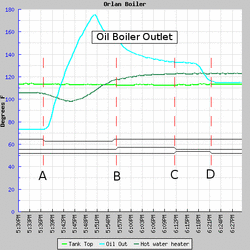We use oil for heating our hot water when there isn't enough sunlight to do solar and it's not cold enough to use the wood boiler. It's always made me crazy that the boiler is still full of hot water and hot cast iron when it's done heating the hot water.
I finally built a system that scavenges that leftover heat and uses it in a variety of ways. Here's a graph showing the process as well as a link to the writeup.
As always comments and suggestions are welcome. If anyone is interested in more details about how to do this, please contact me.
I finally built a system that scavenges that leftover heat and uses it in a variety of ways. Here's a graph showing the process as well as a link to the writeup.
As always comments and suggestions are welcome. If anyone is interested in more details about how to do this, please contact me.


